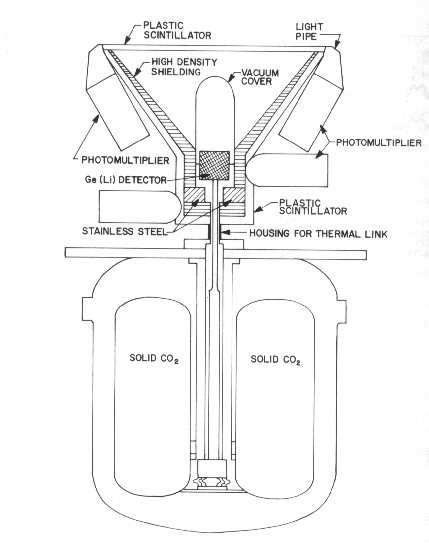|
|
|
|
Radsat
The spin stabilized satellite Radsat was launched by the US Air Force on
2 October 1972 into a noon-midnight, Sun-synchronous orbit. The satellite is
sometimes referred to as 1972-076B (its international launch number) or
P72-1. The inclination was 98.4 degrees; the apogee and perigee were 761 and
736 km, respectively. The cylindrical spacecraft was 2.13 m long and 1.37 m in
diameter. Antenna booms extended 2.74 m from each end, coincident with the
spin axis. The orbital period was 99.5 minutes, and the spin period was 5 s.
The satellite carried 5 instruments: a gamma-ray spectrometer, an extreme
ultraviolet detector, 2 low-altitude particle detectors, and a thermocontrol
coating test instrument. The satellite is not expected to decay into the
atmosphere until the year 2012. The gamma-ray instrument, however, ceased
function after ~7 months.
The gamma-ray detector was a 50 cubic-cm Ge(Li) spectrometer with an active
area of 15 sq-cm. It was cooled by solid CO2. The detector was surrounded by a
W collimator and a stainless steel tungsten rear shield, which was in turn
surrounded by a 4-pi anticoincidence plastic scintillator. The detector
covered the energy range 40 keV - 2.8 MeV, with 4096 channels. The maximum
resolution was ~ 4 keV (FWHM) at all energies. However, this resolution was
short-lived, and during most of the lifetime of the experiment the
resolution was between 10 - 50 keV. Data were accumulated in 1-ms time bins
during a burst. This instrument represented the first high-resolution
germanium spectrometer flown on a satellite.

Several gamma-ray bursts which were also seen by the Vela satellites were
seen by Radsat. A ~60-ms microburst was seen prior to the Vela trigger
time for the 18 December 1972 event. Furthermore, the spectrum was seen to
soften in this event at later times.
- Imhof et al, 1974, Ap J Lett, 191, L7-L10.
- Imhof et al., 1975, Ap J, 198, pp. 717-725.
- E.L. Chupp, Gamma-Ray Astronomy, pp. 238-242.
- The RAE Table of Earth Satellites 1957-1982.
|
|
